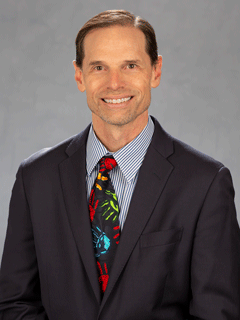A University of Miami pediatrician who is also serving as a United States health care administrator explained the history and current state of newborn screenings across the nation recently, while briefing health care experts who must recommend ways that states can improve upon their screening of babies in the future.
“As all of you know, state newborn screening programs really are a model of public health activity,” said Dr. Jeffrey Brosco, clinical professor of pediatrics at the University of Miami Miller School of Medicine, who also directs the Division of Services for Children with Special Health Needs under the government’s Health Resources and Services Administration (HRSA). “The idea is that we identify infants with serious medical conditions in the newborn period, before any clinical symptoms, and that allows us to intervene early and dramatically improve outcomes.”

He was speaking to 15 health care experts on the National Academies of Sciences, Engineering, and Medicine committee. They were requested by Congress to suggest ways to strengthen existing newborn screening programs and to establish a vision for the next five to 15 years.
In his role with the HRSA, Brosco works with federal partners like the National Institutes of Health and the Centers for Disease Control and Prevention to collect data and improve the system of care for state newborn screening programs across the nation.
By pricking the heel of newborn infants at every hospital, more than 4 million babies are screened each year across the country for many heritable diseases. If left untreated, conditions like phenylketonuria (PKU), sickle cell disease, and severe combined immunodeficiency (also known as SCID), can endanger or threaten the lives of children.
Since the 1960s, states had a patchwork of different newborn screening policies, but in 2003, the persistence of physicians like Dr. Rodney Howell and others at the Miller School paid off and the U.S. Department of Health and Human Services established the recommended uniform screening panel (RUSP), which lists more than 30 critical conditions for states to identify in newborns. The RUSP is updated periodically to add more conditions, based on evidence-based reviews, Brosco said.
Today, newborn screening programs are still run by states, which means that each one has a different number of conditions that they identify in babies. Still, they are much more thorough than before, and most states and U.S. territories have adopted the RUSP, Brosco added. In Florida, newborn blood tests previously identified only seven conditions; but today, the same test screens for 55 different conditions.
Despite the progress, Brosco underscored the need for states and the federal government to continuously communicate about identified conditions, so that they can ensure families get treatment for their newborns. Many of these illnesses require a quick response, or even transplants, to be most effective.
“We all believe as a nation that if we are going to screen for something, we should have an obligation to make sure that child gets treatment,” said Brosco, who also served as Florida’s deputy secretary of health for Children’s Medical Services from 2017 to 2019 and is director of population health ethics at the Miller School’s Institute for Bioethics and Health Policy. “And that’s what we are all working towards—making sure that we get children what they need, so that they can play, go to school, and become healthy adults.”
Also, as technology and science improve, the information that labs can garner from a small blood sample taken from babies will increase monumentally, Brosco said, mentioning the growing role of genetic sequencing today. Therefore, he asked the committee to make suggestions based on the realistic capacity of state-funded newborn screening labs, as well as the importance of using this data to help reduce the number of babies leaving the hospital with treatable conditions.
In 2025 the committee will provide short-term options to strengthen existing newborn screening programs, while also working to offer recommendations to sustain and expand through the next five to 15 years.
To learn more or to watch the presentation, visit the National Academies website.

